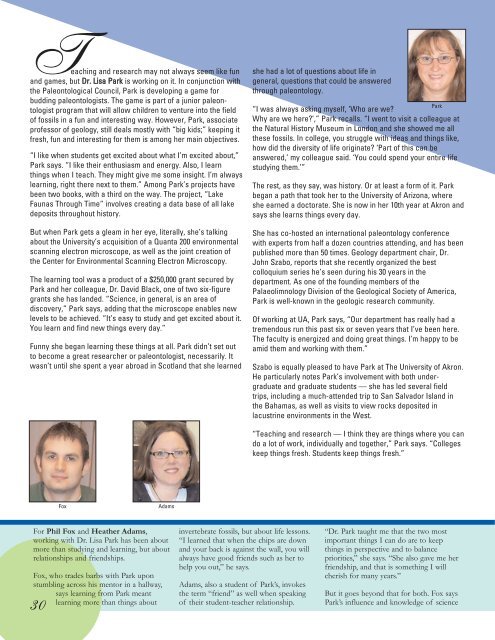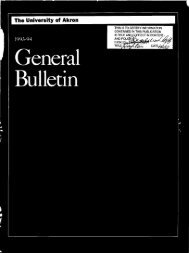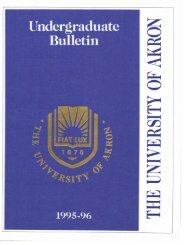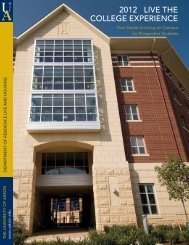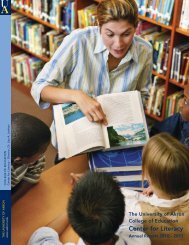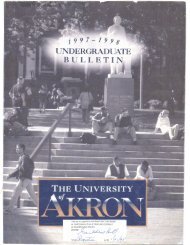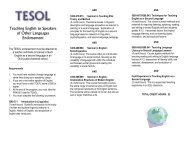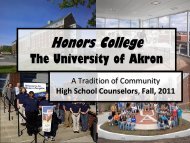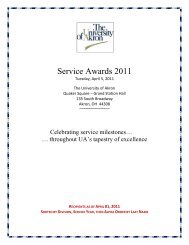2005_vprdoc PSpreads2.qxp - University of Akron
2005_vprdoc PSpreads2.qxp - University of Akron
2005_vprdoc PSpreads2.qxp - University of Akron
You also want an ePaper? Increase the reach of your titles
YUMPU automatically turns print PDFs into web optimized ePapers that Google loves.
Teaching and research may not always seem like fun<br />
and games, but Dr. Lisa Park is working on it. In conjunction with<br />
the Paleontological Council, Park is developing a game for<br />
budding paleontologists. The game is part <strong>of</strong> a junior paleontologist<br />
program that will allow children to venture into the field<br />
<strong>of</strong> fossils in a fun and interesting way. However, Park, associate<br />
pr<strong>of</strong>essor <strong>of</strong> geology, still deals mostly with “big kids;” keeping it<br />
fresh, fun and interesting for them is among her main objectives.<br />
“I like when students get excited about what I’m excited about,”<br />
Park says. “I like their enthusiasm and energy. Also, I learn<br />
things when I teach. They might give me some insight. I’m always<br />
learning, right there next to them.” Among Park’s projects have<br />
been two books, with a third on the way. The project, “Lake<br />
Faunas Through Time” involves creating a data base <strong>of</strong> all lake<br />
deposits throughout history.<br />
But when Park gets a gleam in her eye, literally, she’s talking<br />
about the <strong>University</strong>’s acquisition <strong>of</strong> a Quanta 200 environmental<br />
scanning electron microscope, as well as the joint creation <strong>of</strong><br />
the Center for Environmental Scanning Electron Microscopy.<br />
The learning tool was a product <strong>of</strong> a $250,000 grant secured by<br />
Park and her colleague, Dr. David Black, one <strong>of</strong> two six-figure<br />
grants she has landed. “Science, in general, is an area <strong>of</strong><br />
discovery,” Park says, adding that the microscope enables new<br />
levels to be achieved. “It’s easy to study and get excited about it.<br />
You learn and find new things every day.”<br />
Funny she began learning these things at all. Park didn’t set out<br />
to become a great researcher or paleontologist, necessarily. It<br />
wasn’t until she spent a year abroad in Scotland that she learned<br />
she had a lot <strong>of</strong> questions about life in<br />
general, questions that could be answered<br />
through paleontology.<br />
Park<br />
“I was always asking myself, ‘Who are we<br />
Why are we here’,” Park recalls. “I went to visit a colleague at<br />
the Natural History Museum in London and she showed me all<br />
these fossils. In college, you struggle with ideas and things like,<br />
how did the diversity <strong>of</strong> life originate ‘Part <strong>of</strong> this can be<br />
answered,’ my colleague said. ‘You could spend your entire life<br />
studying them.’”<br />
The rest, as they say, was history. Or at least a form <strong>of</strong> it. Park<br />
began a path that took her to the <strong>University</strong> <strong>of</strong> Arizona, where<br />
she earned a doctorate. She is now in her 10th year at <strong>Akron</strong> and<br />
says she learns things every day.<br />
She has co-hosted an international paleontology conference<br />
with experts from half a dozen countries attending, and has been<br />
published more than 50 times. Geology department chair, Dr.<br />
John Szabo, reports that she recently organized the best<br />
colloquium series he’s seen during his 30 years in the<br />
department. As one <strong>of</strong> the founding members <strong>of</strong> the<br />
Palaeolimnology Division <strong>of</strong> the Geological Society <strong>of</strong> America,<br />
Park is well-known in the geologic research community.<br />
Of working at UA, Park says, “Our department has really had a<br />
tremendous run this past six or seven years that I’ve been here.<br />
The faculty is energized and doing great things. I’m happy to be<br />
amid them and working with them.”<br />
Szabo is equally pleased to have Park at The <strong>University</strong> <strong>of</strong> <strong>Akron</strong>.<br />
He particularly notes Park’s involvement with both undergraduate<br />
and graduate students — she has led several field<br />
trips, including a much-attended trip to San Salvador Island in<br />
the Bahamas, as well as visits to view rocks deposited in<br />
lacustrine environments in the West.<br />
“Teaching and research — I think they are things where you can<br />
do a lot <strong>of</strong> work, individually and together,” Park says. “Colleges<br />
keep things fresh. Students keep things fresh.”<br />
Fox<br />
Adams<br />
For Phil Fox and Heather Adams,<br />
working with Dr. Lisa Park has been about<br />
more than studying and learning, but about<br />
relationships and friendships.<br />
Fox, who trades barbs with Park upon<br />
stumbling across his mentor in a hallway,<br />
says learning from Park meant<br />
learning more than things about<br />
30<br />
invertebrate fossils, but about life lessons.<br />
“I learned that when the chips are down<br />
and your back is against the wall, you will<br />
always have good friends such as her to<br />
help you out,” he says.<br />
Adams, also a student <strong>of</strong> Park’s, invokes<br />
the term “friend” as well when speaking<br />
<strong>of</strong> their student-teacher relationship.<br />
“Dr. Park taught me that the two most<br />
important things I can do are to keep<br />
things in perspective and to balance<br />
priorities,” she says. “She also gave me her<br />
friendship, and that is something I will<br />
cherish for many years.”<br />
But it goes beyond that for both. Fox says<br />
Park’s influence and knowledge <strong>of</strong> science


